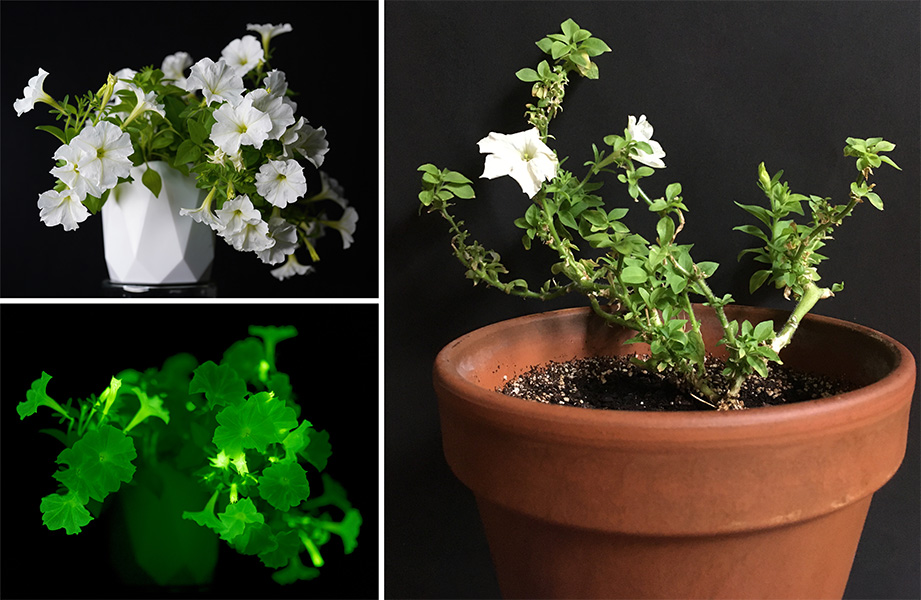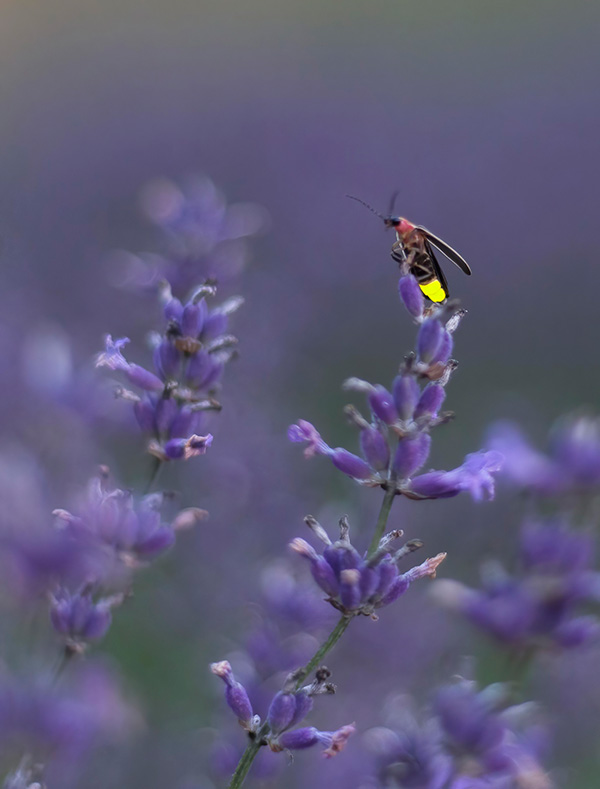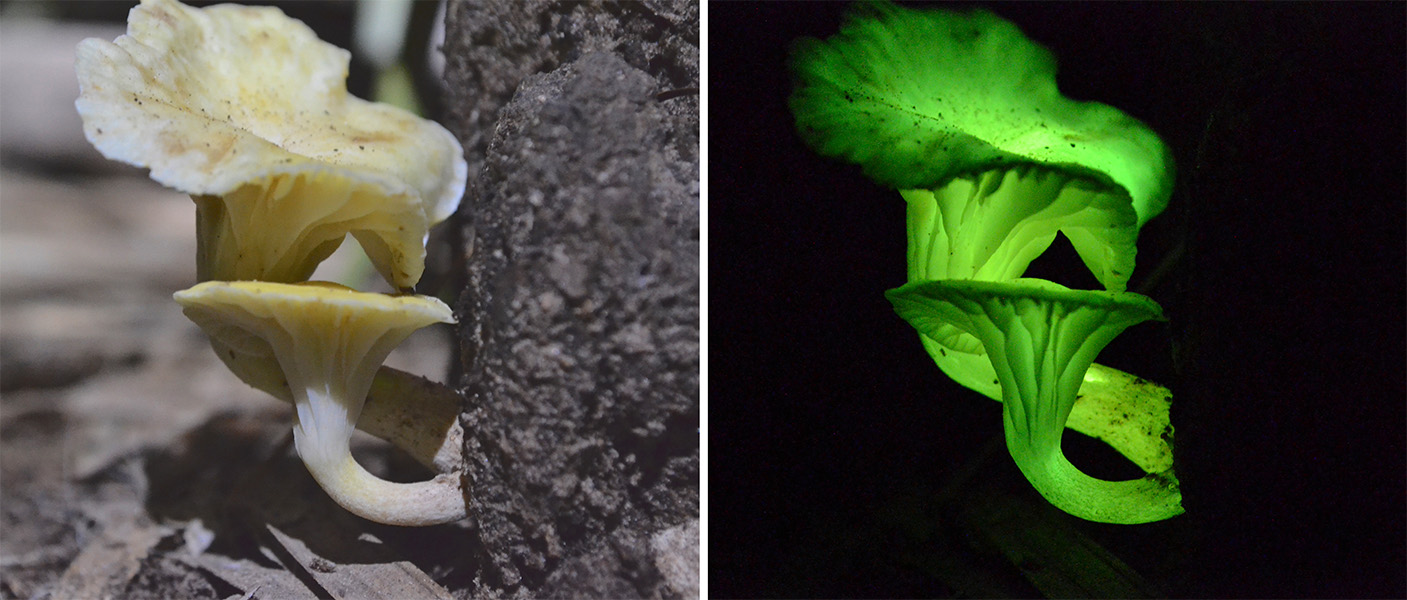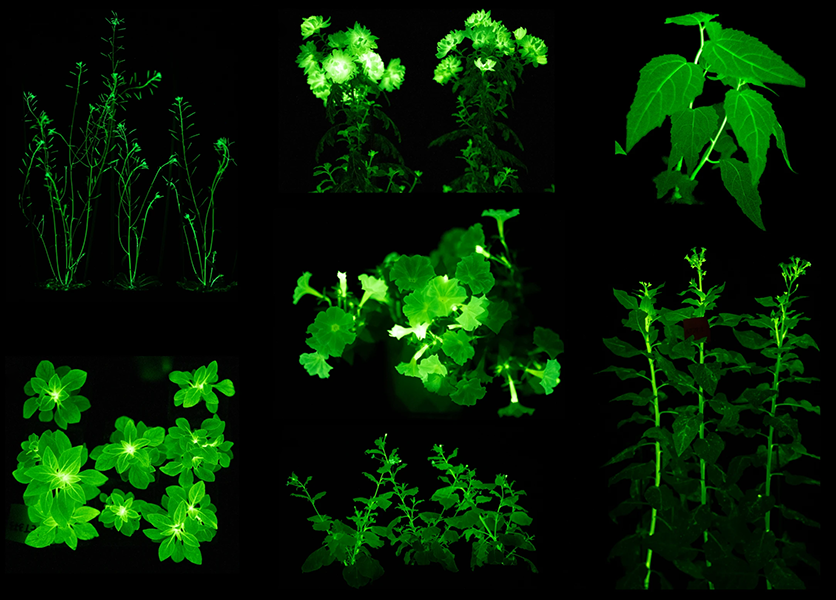What a bioluminescent petunia had to teach me
I bought a glowing plant. It led me down a rabbit hole of radiant mushrooms, 19th century experiments and a modern rivalry between scientists in Russia and the Americas.
Support sound science and smart stories
Help us make scientific knowledge accessible to all
Donate today
Petunias have never done much for me. If you had told me that one day, I’d fork over more than $50 for a single petunia plant, my eyes would have rolled out of my head. But this plant was special. This petunia glowed in the dark.
My plant was one of 50,000 shipped around the United States in April by the Idaho-based biotech start-up Light Bio. Called the “Firefly” petunia, it contains genes from bioluminescent mushrooms that make it constantly glow. A news release announcing the petunia’s arrival included a photo of a woman gazing serenely at a mass of flowers lit up like oversized glow-in-the-dark stars.
Well, that’s a neat trick, I thought.
I also wondered whether the Firefly petunia was more than just a trick. Though it seemed inconsequential, perhaps there was some implication I hadn’t thought of. At the very least, the plant might make me — a great admirer of plants (but a bit of a botanical snob) — think differently about petunias, those go-to ornamentals for gas stations and mansions alike.
I decided to learn more. So I paid my $53 ($29 for the plant, $24 for shipping) and placed an order.

The Firefly petunia’s flower buds seem to give off the most light, as seen with the healthy specimen (left) shown in both daylight and in the dark. The author’s petunia (right) is in recovery after being eaten by some very hungry caterpillars, but its flowers and buds still faintly glow.
CREDITS: LIGHT BIO INC. (LEFT TOP AND BOTTOM) AND R. EHRENBERG (RIGHT)
Behold, bioluminescence
Bioluminescence is the emission of light by living things. It is generated by a chemical reaction within the organism (unlike the phosphorescence of glow-in-the-dark stickers, which need to be charged up with light before emitting it). Bioluminescence is widespread, especially in the oceans: There are bacteria, sea snails, shrimp, fish and squid that glow. Terrestrial glowers include some insects and worms as well as fungi.
Scientists have worked out the precise chemical compounds involved for only a handful of bioluminescent organisms. But for the most part, the basics of the light-producing reaction are the same: It requires fuel, oxygen and a catalyst to get the reaction going. In the parlance of bioluminescence research, the fuel is called the luciferin and the catalyst is called the luciferase. The luciferase helps to add oxygen to the fuel, transforming it into a very reactive, high-energy compound. As this overexcited luciferin relaxes, it emits light.
This ability to produce light has been documented in hundreds of genera across the tree of life. Scientists think it evolved independently in various lineages, perhaps more than 94 different times.
Organisms use bioluminescence in a variety of ways. For fireflies, it’s a come-hither signal that attracts mates. Some fish use it to lure prey. Other animals, such as the vampire squid, which can expel a cloud of glowing mucus, use it to distract or confuse predators. In many lineages, giving off light may have arisen as a detoxification strategy. When oxygen is in a reactive state, it can ricochet through cells and damage molecules. This suggests that many luciferins were antioxidants first; their primary role was to mop up damaging oxygen that had been generated during metabolism.

Fireflies are perhaps the most recognized bioluminescent organisms, but the ability to emit light has been documented in hundreds of genera across the tree of life and has evolved multiple times in multiple lineages.
CREDIT: KIM HADLEY PHOTOGRAPHY / iNATURALIST
Hunting for the fungal glow
Bioluminescent fungi have long grabbed people’s attention. In the fourth century BCE, Aristotle noted that fungi could be “fiery and glittering” in the dark. A few centuries later, Pliny the Elder, in his encyclopedic Natural History, mentions the “brilliant light” emitted by a mushroom that grows on trees. But until recently, no one knew exactly what fungi were using as the fuel or catalyst, or even whether all glowing fungi light up in the same way.
The hunt for fuel and catalyst molecules culminated in 2017 after more than a century of research and a yearslong international race between a scrappy team from the Americas and a well-connected lab in Russia. Yet even before then, scientists had been trying to unravel the mysteries of bioluminescence.
In the 1880s, French physiologist Raphaël Dubois was investigating a click beetle of the genus Pyrophorus, among the brightest of bioluminescent insects. Dubois ground up the glowing parts of the beetle in cold water. They glowed and then faded to nothing. Then he did the same in boiling water: no glow. But when he added the hot mixture to the cold, the mixture glowed. Dubois (who would go on to coin the terms luciferin and luciferase) realized that the reaction required a catalyst and fuel. Only the cold water contained working catalyst — boiling destroyed it. But both hot and cold extracts contained the fuel, which survived boiling. Adding the hot extract to the cold extract provided fresh fuel to the extract with functioning catalyst — and so it generated light.
Decades later, scientists would conduct this hot/cold experiment with bioluminescent fungi, but the identity of the fuel and the catalyst still eluded them.
Roughly 130 fungus species are bioluminescent, says mycologist Dennis Desjardin, emeritus researcher at San Francisco State University, who has described several of those species. Fungi spend most of their lives as webs of thread-like filaments called mycelia, and the mycelia of the bioluminescent fungi give off light, though it’s often hidden within the decaying wood in which many of them grow. In species that bear mushrooms, the mushrooms may glow too.
In 2005, Desjardin began working with chemist Cassius Stevani of the University of Sao Paulo, Brazil, who was looking into how fungi generated their glow. Stevani, along with then-graduate student Anderson Oliveira, had refined Dubois’ hot/cold experiment, adding various cellular chemicals to grease the reaction. After perfecting the protocol, Stevani wanted to perform the hot/cold experiment using different species of fungi, one species for the cold and another species for the hot. These cross-species experiments showed that the different fungi used the same catalyst and fuel, suggesting that bioluminescence had evolved just once in the fungal lineage, Stevani and Desjardin reported in 2012.
“This was very important,” says Stevani. “It was saying, Oh, if you have a fungus in Russia or in Asia, you can use it to study the mechanism, because it’s the same in all fungi.”

The bioluminescent fungus Neonothopanus gardneri from the state of Piauí in northeast Brazil, where the mushrooms grow on the base of babassu palms. Roughly 130 fungal species are bioluminescent.
CREDIT: CASSIUS STEVANI / IQ-USP, BRAZIL
Meanwhile, biochemist Ilia Yampolsky, who now heads a lab at the Russian Academy of Sciences in Moscow, was also hot on the fungal-light trail. Stevani got wind of this development. “I got crazy, of course, because, I was studying this for 15 years,” he says. He wrote to Yampolsky in 2015, suggesting that they collaborate. But the Russians had beaten Stevani to the luciferin punch; their discovery just hadn’t been published yet.
The fungal fuel turned out to be made from an antioxidant called hispidin. Hispidin is found not only in fungi, but also in many plants as well. “The molecule I was searching for, for 15 years — I look out of my window, I see plants that have this molecule,” Stevani says.
Since then, the two teams have collaborated. (“We colluded with the Russians,” Desjardin jokes.) They nailed down details of the biochemical assembly line that leads up to the light-emitting reaction and published the results together in the Proceedings of the National Academy of Sciences in 2018. Stevani got to name the fungal catalyst. He called it luz, the Portuguese word for light.
Out of fungi and into the petunia
A key discovery in the creation of the glowing petunia was the source of the luciferin fuel in the fungi. It’s made from a precursor compound called caffeic acid that is common in fungi and in plants. The fungal assembly line for making light forms a tidy loop — caffeic acid gets converted to hispidin, hispidin gets converted to the fuel, the fuel gives off light and the remaining compound gets converted back into caffeic acid — restarting the loop. Stevani realized that if plants also made that precursor compound, then practically any plant might be engineered to glow. He said as much to Yampolsky. “I said, ‘Man, we have a system that uses caffeic acid. We can transform any plant!’”
Yampolsky replied, “What do you think I am doing?”
Russian synthetic biologist Karen Sarkisyan led the careful work of sorting out the various genes involved in the light-emitting reaction. Then the team stuck those genes — from the bioluminescent fungus Neonothopanus nambi — into a tobacco plant. It worked: The shoots, buds, flowers and even roots — they all glowed. “Plants and fungi, they speak a similar biochemical language,” says Sarkisyan, a cofounder of Light Bio who now runs his own lab at Imperial College London. “And because they speak that similar biochemical language, it was relatively easy to translate the metabolic pathway from the fungus to the plant.”

After some clever genetic tinkering, scientists successfully engineered several kinds of plants to glow using genes from fungi: the mouse-ear cress Arabidopsis thaliana (top left), a chrysanthemum (top middle), poplar (top right), petunia (center and bottom left), Nicotiana benthamiana (bottom middle) and tobacco (bottom right).
CREDIT: E.S. SHAKHOVA ET AL / NATURE METHODS 2024
With a bit more genetic tinkering, Sarkisyan, Yampolsky and their collaborators managed to coax other plants — chrysanthemum, poplar, Arabidopsis and petunia — into glowing. By September 2023, the US Department of Agriculture had approved Light Bio’s request to make and sell glowing petunias, determining that the plants posed no great risks. Five months later, I placed my order.
Oh, Petunia
My petunia looked like an ordinary white garden petunia when it arrived. It was a bit disheveled; I transplanted it into a new pot and gave it some water and a spot by a sunny window. After a few weeks it perked up. When I brought it into a dark closet, its flowers faintly glowed — dimmer than a candle, but glowing nonetheless.
I had intended to look into whether the petunia could wreak any ecological havoc — what if it interbred with wild species and the glowing genes escaped? Might our outdoor spaces be transformed into (very quiet) botanical raves? But the petunia’s light seemed too dim to interfere with much of anything.
Elsa Youngsteadt, who coauthored an article in the 2023 Annual Review of Ecology, Evolution, and Systematics on how constant light in urban environments may influence pollination, basically agreed with me.
She explained that there aren’t any wild native petunias in the United States, which is the only place where the Firefly petunia is currently available. The ubiquitous common garden petunias are all hybrids, the result of a long history of crossing the white-flowered and moth-pollinated Petunia axillaris with a pigmented, bee-pollinated species. These hybrid petunias already present a crazy mix of signals that might confuse a pollinator, says Youngsteadt, a pollination ecology expert at North Carolina State University. And none of them have proved to be invasive in the United States.
So — the Firefly petunia? “I’m not immediately alarmed by it,” Youngsteadt says. But, she adds, “Why would we put time, money and potential risk into making something glow for fun?”
Why indeed. In fact, the more I thought about it, the more I wondered whether popping the fungal genes into the petunia was just the whimsical icing on a cake. The cake — the real marvel — was all the years of gumshoe detective work that went into figuring out precisely how the fungi got their glow. And that made me look at my petunia with a fondness that surprised me.
10.1146/knowable-081224-1
TAKE A DEEPER DIVE | Explore Related Scholarly Articles




